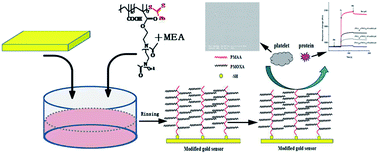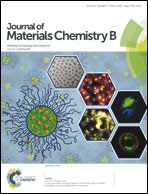Antifouling property of monothiol-terminated bottle-brush poly(methylacrylic acid)-graft-poly(2-methyl-2-oxazoline) copolymer on gold surfaces†
Abstract
In this study, a series of well-controlled bottle-brush polymers, poly(methylacrylic acid)-g-poly(2-methyl-2-oxazoline) with monothiol-terminated group ((PMAA-g-PMOXA)-SH) were synthesized by using reversible addition-fragmentation chain transfer (RAFT) polymerization and cationic ring-opening polymerization (CROP). (PMAA-g-PMOXA)-SH were grafted to the surface of gold sensors in in situ aminolysis reactions. Cyclic voltammetry (CV), X-ray photoelectron spectroscopy (XPS), variable angle spectroscopic ellipsometry (VASE), water contact angle (CA), and atomic force microscopy (AFM) were used to characterize the copolymer modified gold sensor. The protein-resistant properties were investigated by surface plasmon resonance (SPR), and platelet adhesion was observed by scanning electron microscopy (SEM). Compared with the bare gold sensor, the (PMAA20-g-PMOXA12)-SH modified gold sensor can reduce the levels of fibrinogen (Fg), bovine serum albumin (BSA), and lysozyme (Lyz) adsorption by 96.5 ± 3.1%, 85.8 ± 5.7%, and 49.4 ± 1.6%, respectively. Meanwhile, the (PMAA20-g-PMOXA12)-SH modified gold sensor also possesses excellent resistance to platelet adhesion. All these data demonstrate that this simple method is feasible, and that a bottle-brush (PMAA-g-PMOXA)-SH modified gold sensor has potential applications in biosensors and biomedical areas.


 Please wait while we load your content...
Please wait while we load your content...